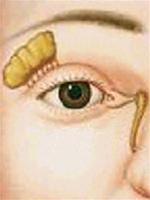Congenital congenital
Leaning is the pathway system that moves tears from the perforation area to the lower nasal passage. Tears enter the lacrimal passage through the lacrimal point, flow in the larynx, lacrimal sac, nasal tear duct and flow into the nasopharynx through the nasal passages.
When tears do not flow into the lacrimal flow but flow out, causing the phenomenon of live lacrimation, the most common cause is due to the rule of practice, especially for newborns. When detecting that children have tears in their eyes or often find stagnant water in the eyelids, they should be taken immediately to seek medical care for right and timely treatment.
Common congenital morbidity
No score:
In newborns, parents often find their eyes always wet, stagnant tears in the eyelids, or children often suffer from prolonged conjunctivitis. At that time, parents need to let their children go to the eye specialist hospital immediately. Doctor examination found no score in normal position. The treatment will be case-by-case, if observing the mark of the perforation point through the tear film, it is possible to cut this membrane and the rule will clear; If the gullet is complete, surgery can only be performed with nasal perforation when the child has grown.
Congenital bagging:

(Photo: TTO)
Young parents often find a small hole near the inner corner of the eye. When children grow up, sometimes tears may flow through this hole.
The examination showed that there was a hole in the skin in front of the lacrimal sac, when the pump was directed, the water would flow through this hole. Treat by closing the perforation hole.
Congenital nasal congestion:
This is the most common form of disease in newborns. About 2 to 4% of term infants have a blocked nasal tear duct at 2-4 weeks of age. Among them, about one-third of children have a blocked nasal duct in both eyes.
Most congenital nasal congestion will clear itself when your baby is 2-6 months old.
Tears are the most common symptom. The degree of tearing may change, many may drip or just wet the lash. If long-term occlusion will detect mucous pockets in the corner of the eye. The disease can cause prolonged conjunctivitis.
Examining the sacral area, it can be seen that the mucus pus oozes out from the spot. Pumping the water flow into the opposite point. Water spurted out may have mucus pus.
Congenital congenital treatment
The treatment depends on the age of the child to the examination and can apply different treatments:
For children younger than 2 months old : Mainly treated by day, massaging the sacral area, combined with the use of eye examination antibiotics if accompanied by inflammation. It is not recommended to pump the practice in this period because it is easy to damage the path. Moreover, during this period the religion can be self-informed.
Children from 3-12 months old : Treatment with a conventional pump, the results are very positive.
Children older than one year : Conventional conventional pumps are often ineffective. Treatment is mainly done by connecting the nasal sac with the sac of the nasopharynx when the child is older or proceeding to place the silicon through the two larynxs to help the tears flow down the nose.
MSc. Doctor HUYNH THI THU BA (International Department of Ophthalmology BV. An Sinh)
- Going to cure congenital olfactory loss?
- Detection of the 15th gene causes congenital blindness
- Find the recessive gene that causes congenital blindness
- Congenital haemorrhage - The disease is hard to cure, easy to prevent
- New breakthrough in the treatment of congenital heart defects
- Fix heart defects within 20 minutes
- Congenital chest concave and health consequences
- Gene therapy interventions can cure congenital deafness
- Identify and treat congenital bleeding
- Strange story: The one-eyed boy was born in Egypt
- New step in treating blind patients
- Diabetic mother, child at risk of birth defects
 Green tea cleans teeth better than mouthwash?
Green tea cleans teeth better than mouthwash? Death kiss: This is why you should not let anyone kiss your baby's lips
Death kiss: This is why you should not let anyone kiss your baby's lips What is salmonellosis?
What is salmonellosis? Caution should be exercised when using aloe vera through eating and drinking
Caution should be exercised when using aloe vera through eating and drinking